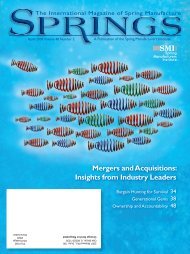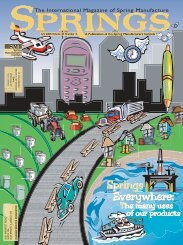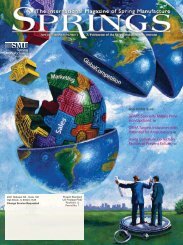Solid Height - Spring Manufacturers Institute
Solid Height - Spring Manufacturers Institute
Solid Height - Spring Manufacturers Institute
You also want an ePaper? Increase the reach of your titles
YUMPU automatically turns print PDFs into web optimized ePapers that Google loves.
Figure 4: Hypothetical relationship depicting the amount of<br />
stress relief vs. time for steel springs.<br />
Stress relaxation can be critical for some hightemperature<br />
applications. Stress relieving cycles can<br />
be optimized to minimize relaxation. An old rule of<br />
thumb is that the stress relaxation temperature<br />
should be at least 100°F higher than the maximum<br />
service temperature.<br />
Practical Application<br />
<strong>Spring</strong>s are typically stress relieved using batch<br />
ovens or in-line conveyer furnaces. The cycle time for<br />
in-line or high-heat-transfer furnaces can be shorter<br />
than for the batch furnaces. This is accomplished by<br />
increasing the heat transfer in the furnace and by<br />
taking advantage of the time/temperature thermal<br />
relationship evident in particular grades of steel.<br />
Larson and Miller created a mathematical model<br />
for this effect in order to produce valid test results<br />
that substituted long test times for elevated test<br />
temperatures. Their model proposed that many different<br />
time/temperature combinations existed that<br />
could produce a similar thermal effect. For stress<br />
relieving steel springs this relationship may not be<br />
perfect, but it can be used as a good starting point<br />
to help predict the proper stress relief cycle. Most<br />
stresses are relieved in the first minutes after the<br />
steel is at temperature. For one particular temperature,<br />
a theoretical relationship is shown in Figure<br />
4, above.<br />
One of the basic assumptions of the Larson-<br />
Miller parameter is that no structural changes occur<br />
in the metal over the range of temperatures being<br />
examined. Certain temperatures on some alloy systems<br />
may produce a significant metallurgical change<br />
that may affect the slope of this relationship. When<br />
this situation occurs, experimental data should be<br />
used [3]. For alloys like 17-7PH that can be age hardened<br />
at a very specific temperature, the Larson Miller<br />
equation would not apply for temperature ranges<br />
around 900°F.<br />
In general, it’s a good idea to stress relieve all<br />
springs in a timely manner, and many springmakers<br />
do this. However, to properly stress relieve springs<br />
fabricated from different materials or containing<br />
severe bends, it is important to realize that one size<br />
doesn’t fit all. Be on the lookout for that occasional<br />
spring that encounters “a few” failures every year.<br />
Does this spring have a low index? Is the material<br />
chrome silicon? For torsion springs, does it tend to<br />
crack at the bends in the arms before plating? If you<br />
can answer “yes” to any of these questions, consider<br />
reviewing the stress-relief process to ensure that it<br />
fits the application.<br />
The author thanks Loren Godfrey, president of<br />
Colonial <strong>Spring</strong> in Bristol, CT, for consulting on this<br />
article.<br />
For further information on the stress relief of<br />
springs, refer to Mark Hayes’ “Cautionary Tales”<br />
Parts VIII and IX, which appeared in the December<br />
2001 and February 2002 issues, respectively.<br />
References<br />
1. Parrington, Ron, Hydrogen Damage and<br />
Embrittlement, ASM Handbook, Volume 11 Failure<br />
Analysis and Prevention, Editors: W. Becker and R.<br />
Shipley, ASM International 2002, pp. 809-811.<br />
2. Dieter, G.E., Mechanical Metallurgy, Sanjeev<br />
Rao, McGraw-Hill, 1986, pp. 201-203.<br />
3. Dieter, G.E., Mechanical Metallurgy, Sanjeev<br />
Rao, McGraw-Hill, 1986, pp. 461-462. v<br />
Don’t Let OSHA Play<br />
Games with Your Company!<br />
Hidden Hazards can be Dangerous and<br />
Expensive! SMI’s On-Site Safety Audit will identify<br />
safety hazards and recommend abatements .<br />
The confi dential audit includes a preliminary interview, a<br />
review of the company’s written programs, a plant fl oor<br />
inspection and a detailed, written, post-audit report.<br />
Cost: $1,000 for SMI Members<br />
$1,250 for Nonmembers<br />
For more information, contact Jim Wood,<br />
SMI Regulations Complaince Consultant<br />
Phone: 630-495-8597 Fax: 630-495-8595<br />
E-Mail: regs@smihq.org<br />
SPRINGS July 2006 43





